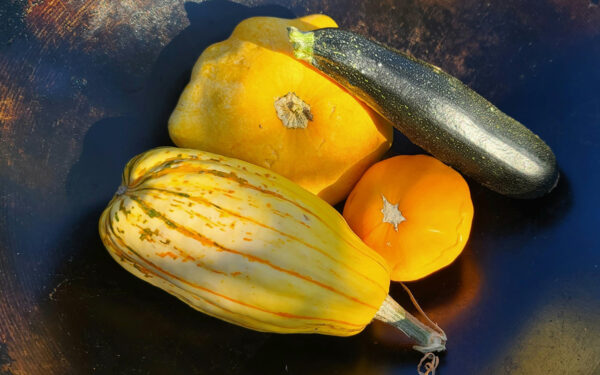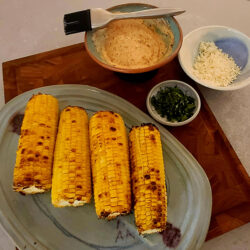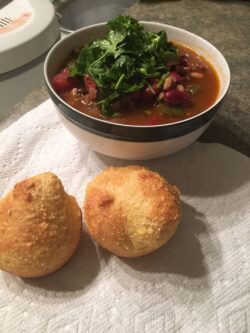The Three Sisters of Fall Foods

It’s fall, and always fun to harvest the fruits of my labors from the spring and summer. Coming in now are the veggies that some Indigenous people call “the three sisters”—beans, corn and squash.
The idea is that these three plants support each other like sisters should. The beans help put nitrogen into the soil, which corn and squash need. The corn supports the bean and squash vines, and the big leaves of the squash and pumpkin plants shade and cover the soil, keeping it moist and weed free. In short, they all thrive better together than alone.
In addition to growing well together, beans, corn, and squash complement each other nutritionally. Corn is low in two amino acids—lysine and tryptophane—but beans have lots of lysine, which is why Indigenous cultures figured out beans and corn were a healthy combination. Beans don’t have much tryptophane, but squash and pumpkin seeds have a good amount. Eating these complementary foods together makes them better together than alone.
Following are several recipes for these beneficial foods. Note that most Mexican Street Corn recipes call for mayonnaise, but it is a higher sodium ingredient. Mexican crema or sour cream is a wiser choice and leaves you room in your planning for a small amount of saltier cotija cheese, which is traditional. You should find it in your grocery dairy case. You can substitute grated parmesan cheese, but I think the cotija is better.
Elote (Mexican Street Corn)

Corn on the cob, crema, cilantro, and cotija cheese for delicious Mexican Elote.
6 ears of corn, husked (substitute 1 small bag of frozen corn if out of season)
½ cup of Mexican crema, or sour cream
¼ teaspoon cayenne pepper, more to taste
1 tablespoon lime juice
Lime wedges
¼ cup minced cilantro
½ cup crumbled cotija cheese
Grill the corn under your oven broiler (or on a barbeque or in a skillet on the stove) until ears are tender and somewhat charred. Mix together crema or sour cream, pepper, lime juice, and cilantro. Brush over ears just before serving. Sprinkle with crumbled cotija cheese.
If you use frozen corn, sauté it in a saucepan with a teaspoon of oil, remove from heat when slightly charred, and mix in sauce.
Garnish with cotija and serve with lime wedges.
Nutrition Information (six servings)
Calories: 131, Carbohydrates: 7 grams, Protein: 6 grams, Sodium: 149 milligrams
Roasted Squash with Seeds
1 acorn or butternut squash, cut in half and seeded
2 tablespoon unsalted butter
2 teaspoons brown sugar
3 tablespoons pineapple, crushed
1/4 teaspoon nutmeg
Preheat oven to 425 degrees. Place squash cut side up in greased baking pan. Place one teaspoon butter plus one teaspoon brown sugar in each squash half. Cover squash with aluminum foil and bake until tender, approximately 30 minutes.
For Acorn squash, scoop cooked squash out of shells, leaving a ¼-inch thick shell. For Butternut, just remove skin and mash squash.
Mix cooked squash, pineapple, 1 tablespoon butter, and nutmeg. Beat until smooth. For Acorn squash, spoon mixture into shells.
Bake in 425-degree oven for approximately 15 minutes. For Butternut, put squash mixture in small casserole and bake in 425-degree oven for about 15 minutes.
Nutrition Information (four servings)
Calories: 202, Carbohydrates: 31 grams, Protein: 2 grams, Sodium: 90 milligrams
Roasted Sunflower or Pumpkin Seeds
Remove seeds from squash or pumpkin or buy pepitas (pumpkin seed kernels). Mix 2 cups seeds with 1½ tablespoons of melted butter and ½ teaspoon Worcestershire sauce. Spread seeds on a 10×15 inch baking pan and bake at 250 degrees. Stir occasionally until browned and crisp, about 2 hours. Serve warm or cool. Store the seeds in an airtight container (make sure they are fully cooled) for up to 2 weeks. Sprinkle in salads, add to yogurt, sprinkle on roasted squash or on Three Sisters Soup.
Nutrition Information (serving size: 2 tablespoons):
Calories: 199, Protein 10 grams, Carbohydrates: 4 grams, Sodium: 6 milligrams
Three Sisters Soup

Three Sisters Bean Soup—a fall favorite!
½ cup dried white beans*
½ cup dried pinto beans*
½ cup red beans*
2 cups frozen corn
¼ cup olive oil
1 onion, diced
2–3 cloves garlic, minced
3 celery ribs, chopped
¼ cup minced fresh parsley
2–3 cups chopped fresh or canned tomatoes
½ cup roasted pumpkin or squash seeds or pepitas
½ teaspoon black pepper
¼ teaspoon red pepper
*You may substitute canned low sodium beans—each can equals about ½ cup of dried beans.
Combine all beans in large pot. Add about 5 cups of water and soak overnight. (Alternatively, you can use canned low-sodium beans.) Simmer beans in soaking water, until soft, about 2 hours. Add black and red pepper when beans are almost tender. In a large skillet, heat oil; add onion, garlic, celery, and parsley; and cook until tender. Add corn and tomatoes and cook until heated. Add corn and tomato mixture to beans and serve with squash or pumpkin seeds and Mexican crema or sour cream to garnish.
Nutrition Information (six servings)
Calories: 280, Carbohydrates: 27 grams, Protein: 10 grams, Sodium: 43 milligrams
 Contributor Katy G. Wilkens recently retired as registered dietitian and department head at Northwest Kidney Centers. The National Kidney Foundation Council on Renal Nutrition has honored her with its highest awards for excellence in education and for significant contributions in renal nutrition. She has also been awarded the Medal of Excellence in kidney nutrition from the American Association of Kidney Patients.
Contributor Katy G. Wilkens recently retired as registered dietitian and department head at Northwest Kidney Centers. The National Kidney Foundation Council on Renal Nutrition has honored her with its highest awards for excellence in education and for significant contributions in renal nutrition. She has also been awarded the Medal of Excellence in kidney nutrition from the American Association of Kidney Patients.
Photos by Rich Wilkens.
Eating Well, Living Well classes
Studies show that working with a registered dietitian can delay kidney failure and postpone dialysis for longer than two years. FREE nutrition classes taught by Katy’s former team of registered dietitians are available at convenient times and locations around Puget Sound.
Eating Well, Living Well classes teach people how to eat healthier to slow the progress of kidney disease and postpone dialysis. Learn more at www.nwkidney.org/classes.
![AgeWise King County [logo]](https://www.agewisekingcounty.org/wp-content/themes/agewisekingcounty/images/logo.png)